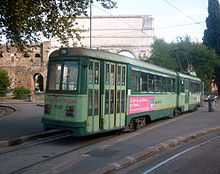Trams in Rome
| Trams in Rome | |||
|---|---|---|---|
 | |||
| Background | |||
| Locale | Rome | ||
| Transit type | Tram | ||
| Number of lines | 6 | ||
| Number of stations | 192 | ||
| Operation | |||
| Began operation | 1877 | ||
| Operator(s) | ATAC | ||
| Number of vehicles | 164 | ||
| Technical | |||
| System length | 40 km (25 mi)[1] | ||
| Track gauge | 1,445 mm (4 ft 8⅞ in)[2] | ||
| |||


The current Rome tram system is a leftover from what once was the largest tram system in Italy. With its fragmented structure, it does not currently function as a backbone of the city's public transport. The system is owned and operated by Agenzia per i Trasporti Autoferrotranviari del Comune di Roma (ATAC SpA).[2]
Network
The key node of the tram network in Rome is Porta Maggiore, where four out of six lines meet (3, 5, 14 and 19), as well as the Rome-Pantano railway. This is about 1 km east of Roma Termini railway station, and not connected to the metro network.
The following lines currently run:
- 2 Piazzale Flaminio ↔ Piazza Mancini
This short line runs through the Flaminio neighbourhood, connecting at Piazzale Flaminio (near the Porta del Popolo) with Line A and the Rome-Viterbo railway line. Some runs of the 2 on weekdays (marked as 2/) run from Piazza Mancini to Piazza Risorgimento, running with the 19 across the Tevere to the Vatican.
- 3 Piazza Thorvaldsen (in the Villa Borghese) ↔ Trastevere railway station.
Partially reopened on August 27, 2012. This is the longest line after line 19, going round the city centre in a wide arc from north via east to south-west. At the western endpoint Trastevere railway station, this line connects with the Regional railways (lines 1, 3 and 5), while connections with Metro A are at Manzoni and San Giovanni. There are four connections with metro Line B: one at Policlinico, and three on the stretch Piramide - Circo Massimo (Rome Metro) - Colosseo, where line 3 follows Metro B on the surface. From the Roma Trastevere railway station to Piazzale Ostiense, the line is still served by the 3B bus line.[3]
- 5 Roma Termini railway station ↔ Piazza dei Gerani.
This line runs east from Termini railway station. It connects with line A at Termini metro station, Piazza Vittorio Emanuele II and Manzoni.
- 8 Piazza Venezia ↔ Via del Casaletto.
Line 8 is the newest line of the system, always running with modern stock. It also reaches furthest into the historic city centre, connecting it with Trastevere railway station. Although there are plans to extend the line eastward from Largo Argentina to Termini railway station, Rome's mayor Alemanno spoke of a new terminus west of Largo Argentina, at via delle Botteghe Oscure, in August 2010.[4] Works for the extension began on June 19, 2012 [5] and the new terminus, located in piazza Venezia, was opened on June 6, 2013.[6]
- 14 Stazione Termini ↔ Viale Palmiro Togliatti
This line mostly follows the route of line 5.
- 19 Piazza Risorgimento ↔ Piazza dei Gerani.
This line connects the Vatican with the rest of the tram network, following the route of first line 3, and then line 5. It connects with the metro at Ottaviano – San Pietro – Musei Vaticani, Lepanto (Rome Metro) (both Line A) and Policlinico (line B). Line 19 is the longest line, connecting with all other tram lines, except for line 8.
History
Rome had horse buses after 1845, when pope Gregory XVI authorized a line from Piazza Venezia to the Basilica di San Paolo fuori le mura to transport pilgrims. This first line did not run according to a timetable; trams left when they were full. Horse trams arrived in 1877, connecting Piazzale Flaminio with the Ponte Milvio, the current line 2.
In 1895, electric trams arrived, connecting Termini station to Piazza San Silvestro. By 1904, all horse tram lines had been electrified – the Ponte Milvio tram last. By 1905, a total of 17 tram lines was operating, using 144 electric vehicles, with a number of horse-drawn trams functioning as backup.
After a few years of competition with the incumbent company SRTO, in 1929, government-controlled company ATAG (Azienda Tranvie Autobus del Governo di Roma) took over the whole network, and by the end of that year, the network had reached its largest extent: no fewer than 59 lines along 140 km of track. As many lines shared parts of their routes, a large reorganization took place in 1930: from then on, two circular lines functioned alongside 24 radial lines, which all started out from the inner ring (the 'black ring'), and crossed the outer ring (the 'red ring'). Within the inner ring, all tram lines were cancelled and substituted by autobuses. 40 kilometers of tracks were dismantled, and part of the older rolling stock was demolished.
After the Second World War, the operating company changed its name to ATAC (Azienda Tranvie ed Autobus del Comune di Roma), but the network kept shrinking. The inner ring was deactivated in 1959; the outer ring only ran in one direction from that year until reconstruction in 1975. The connection Piazzale Flaminio-Ponte Milvio was cancelled in 1960 and reconstructed in 1983 (northern part) and 1990 (southern part). Line 8 was opened in 1998. There are plans to open more lines, including connections from the current northern terminus of line 8 to Termini, and a line from the same terminus towards the Vatican.
SRTO stock
Horse trams
The number of horse trams is unknown, but there were probably over a hundred.
Motorcars
- serie 200: two axles, two engines, 102 built between 1895 and 1905
- serie 300: two axles, two engines, 70 constructed between 1902 and 1907; called torpedinieri
- serie 400: two axles, two engines, 79 constructed between 1908 and 1911
- serie 800: only 4 trams
Cars
- serie 1000: 40 two-axled cars, built between 1909 and 1911, scrapped in 1930.
- serie 1100: only four cars, for the serie 800
ATAC stock

This list includes all stock of the ATAC (including that running under its former names AATM, ATM, ATG, ATAG, ATAC or the Trambus brand.)
Two-axle motorcars
- 91 motorcars with 6 windows, built 1911–1914. One car is preserved in the Seashore Trolley Museum in Kennebunkport, Maine, United States.[7]
- 56 motorcars, similar to the above, built 1919–1921.
- 40 motorcars with 7 windows, built 1921–1923
- 280 motorcars, built 1923–1929. One car preserved by the Gruppo Romano Amici della Ferrovia.
Trailers
- a giardiniera, 107 cars
- 6 windows, 237 cars
- 8 windows, 129 cars
Trams currently in use
ATAC Series 7000 (7001–7115)
After the positive experience with trams 401–412 (1937), in 1940 ATAG commissioned the Mechanical Workshops of Stanga of Padua to build an articulated prototype tram. The prototype, delivered in 1942 and numbered 7001, operated briefly and was destroyed in the bombing of Rome on July 19, 1943. The order was confirmed, however, and the delivery of 50 cars (7003–7099, 7001) occurred between 1948 and 1949.
These cars, which have undergone an operation for modernization in the 1980s, are still in operation in Rome, with the exception of 7073 and 7093 that were recently scrapped. Number 7021 has been transformed into "Ristotram".
A further order of eight similar trams was made in 1953 (7101–7115, odd numbers only). These were later modernized by ATAC at the Viberti workshops.
Cityway I (9101–9128)
These double-articulated trams were ordered from Cityway Fiat Railway in 1998 to mark the opening of line 8. 28 trams were ordered. 70% of its length is low-floor; raised floor sections are located at the ends. The entire train measures 31 meters. One innovation introduced was the air conditioning system. Currently they are in regular operation on lines 2 and 8.
Cityway 2 (9201–9252)
In 1999 another 52 articulated trams were ordered from Fiat-Alstom, following the new trend of 100% low-floor trams. The tram is made up of four sections mounted on separate trucks, and alternate with three suspended sections. The length is 33 meters. The cars 9217 and 9218 are prototypes which never entered into service, which had additional articulated sections, forming a vehicle of 41.45 meters in length, with 9 sections and 5 trucks. These trams are used only for line 8.
Trams in film
In the course of time, hundreds of films have been filmed in Rome, partly due to the presence of the studios at Cinecittà. Trams feature in some of them:
- I soliti ignoti, 1956
- Roma città aperta, 1945
- Ladri di bicyclette, 1948
- Umberto D., 1949
- Totò e Marcellino, 1958
- Io, Chiara e lo scuro, 1982
- Tre uomini e una gamba, 1997
- Il ferroviere, 1957
- Roma, 1970
- Intervista, 1987
Bibliography
- Piero Muscolino & Vittorio Formigari, Tram e filobus a Roma, Cortona: Calosci, 1979/1999.
- Vittorio Formigari & Mauro Di Pietrantonio, Tram e trasporto pubblico a roma
Notes
- ↑ "ATAC Mobility figures" (in Italian).
- ↑ 2.0 2.1 Webb, Mary (ed.) (2010). Jane’s Urban Transport Systems 2010–2011, p. 195. Coulsdon, Surrey (UK): Jane's Information Group. ISBN 978-0-7106-2915-9.
- ↑ http://www.agenziamobilita.roma.it/comunicati/dal-27-agosto-torna-il-tram-3.-sui-binari-15-jumbo-tram-da-240-a-295-posti.-dal-24-agosto-cambia-la-viabilita-di-un-tratto-di-via-statilia.-in-viale-carlo-felice-solo-tram-sulla-preferenziale.html
- ↑ http://www.tramroma.com/att_roma/att_2010_2.htm#0208
- ↑ http://www.comune.roma.it/wps/portal/pcr?contentId=NEW341424&jp_pagecode=newsview.wp&ahew=contentId:jp_pagecode
- ↑ http://www.romacapitalenews.com/trasporti-inaugurato-nuovo-capolinea-del-tram-8-a-piazza-venezia/
- ↑ Car 279 at the Seashore Trolley Museum.
External links
| Wikimedia Commons has media related to Trams in Rome. |
- Gruppo Romano Amici della Ferrovia
- Romatram
- sito istituzionale ATAC
- Municipality of Rome, dept. of transport
| |||||||||||||||||||
| |||||||||||||||||||

.svg.png)
